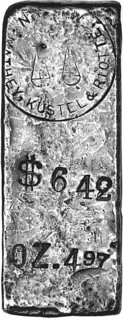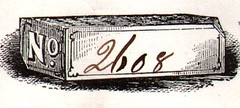
PREV ARTICLE
NEXT ARTICLE
FULL ISSUE
PREV FULL ISSUE
BOOK REVIEW: ANATOMY OF AN INGOT
The author has clearly done a tremendous amount of research in the obscure but fascinating field of precious metals assaying in the early mining days of the American West. Focusing on three assayers associated with the ingot (Mathey, Kustel and Riotte), the book spans the second half of the 19th century and covers much of the early mining history in California and the territories of Arizona and Nevada. The ingot was lot #3524 in the October 16, 2007 Stack's Ford Sale Part XXI. Its earlier provenance includes the Waldo Newcomer collection, B. Max Mehl and Art Kagin.
The most significant of the three assayers was Guido Kustel, who worked in the early San Francisco assay business with well-known names such as Wass, Molitor and Harazsthy. A German trained Mining Engineer and Metallurgist, Kustel ventured off to the Apache infested mountains of Southern Arizona to build the first assay and refining facilities at the famous Heintzelman Mine. He returned to California just in time to become one of the principal players in the early Comstock mining boom in Nevada. Although not a household name today, Kustel was one of the most famous mining engineers and assayers of his day, publishing three books that became ‘must haves’ for every mining engineer. He returned to San Francisco where he set up a number of assay offices and refineries. The second player was Eugene N. Riotte, also trained in Germany, who travelled to Nevada just in time to participate in the newly discovered Reese River silver mines around Austin. He was later involved with a number of other assayers and mining engineers in solving the problems in refining the complex silver ores of Nevada. The third member, Henry Mathey, emigrated from the gold mines of South America to the early mines of Darwin near Death Valley. Joining Kustel and Riotte in 1880 they set the stage for the origin of the silver ingot in question, but not in a way that one might have guessed. Mathey would go onto other achievements including developing the first tin mine in the United States. While numismatists interested in these rare early ingots would certainly enjoy the book, there are tidbits throughout that can enlighten those interested in pioneer gold coinages and the early history of the San Francisco Mint. The list of characters appearing in the book is a long one. I was pleased to see discussions of Agoston Haraszthy, the San Francisco Mint Assayer who was accused of stealing gold but was exonerated in the end when it was discovered that the unaccounted-for gold had gone up the chimney and been deposited on the roofs of nearby buildings. Naturally, this discovery led to improvements in the gold processing process. Haraszthy later founded a pioneering winery that still exists today in the wine country north of the city. Franklin's book alerted me to the existence of a biography: "McGinty, Brian, Strong Wine, The Life and Legend of Agoston Haraszthy, 1998, McGinty does a fine job researching and detailing the life of Agoston Haraszthy, one of America's most fascinating men."

Figure 89, Page 137

Figure 24, Page 43 In addition to the great back-of-the-book research documentation, there are detailed footnotes on every page. Note #97 describes the source of the above sample of the scrip notes used at the Heintzelman Mining Co. of Tubac, Arizona Territory. The lion denotes the $10 denomination (and ten lions are depicted at the left and right sides of the note). This is an unusual style of scrip, and I'd never seen a note by this issuer before. The footnote is particularly tantalizing because the source is unpublished. Kudos to author Franklin for uncovering this gem (and so many others). Here's the text of the note:
Butterworth, Arthur S., Unpublished paper, Paper Money in Arizona, Arizona Historical Society, Ephemera file, "Money" and the Gustave Schneider Collection, MS 715, Box 4, folder 32; the series of script denominations used common animals to denote value and included 12 1/2 c (a pig), 25 c (a Clf), 50 c (a rooster), $1 (horse), $5 (a bull), and $10 (a lion).


Figures 129 and 130 , Page 193 Chapter 16 is titled "Re-Examination of the Ingot". It's a short chapter. The book never questions the authenticity of the ingot, but with a provenance back to the Newcomer collection it hasn't been entangled in the Ford controversies. Rather, this chapter is about using the knowledge gained in the book's research to fill in the gaps in the ingot's weakly-struck lettering. The letters N, Y, M, W would represent New York Metallurgical Works, a probable sequence of letters that partially appears on the subject ingot's logo stamp. Now the design of the complete logo stamp used, along with the center image of assayer's scales is easily reconstructed (Compare figures 129 nd 130). It now becomes somewhat easier to date the subject ingot: it was most probably made in the second half of 1880 just after the founding of the New York Branch given its low serial number and the stamp containing all three names, Mathey, Kustel and Riotte. Author Franklin adds: Figure 130 was a copy of figure 129 on which I edited some changes extrapolated from my research towards representing how the original logo punch might have appeared. As a numismatic bibliophile I'm clearly thrilled with the book. With its narrow focus on assaying and mining though, it won't be every numismatist's cup of tea. But anyone with an interest in this fascinating era of history should enjoy reading it, and it will be a fine companion to titles such as Dan Owens, California Coiners and Assayers, Q. David Bowers, A California Gold Rush History, Donald Kagin, Private Gold Coins and Patterns of the United States (upcoming 2nd edition), and one of my favorite obscure numismatic-related books, Brian McGinty, Haraszthy at the Mint.
To read the earlier E-Sylum article, see:
NEW BOOK: ANATOMY OF AN INGOT
(www.coinbooks.org/esylum_v16n33a04.html)
The Numismatic Bibliomania Society is a non-profit organization promoting numismatic literature. See our web site at coinbooks.org. To submit items for publication in The E-Sylum, write to the Editor at this address: whomren@gmail.com To subscribe go to: https://my.binhost.com/lists/listinfo/esylum All Rights Reserved. NBS Home Page Contact the NBS webmaster 
|


